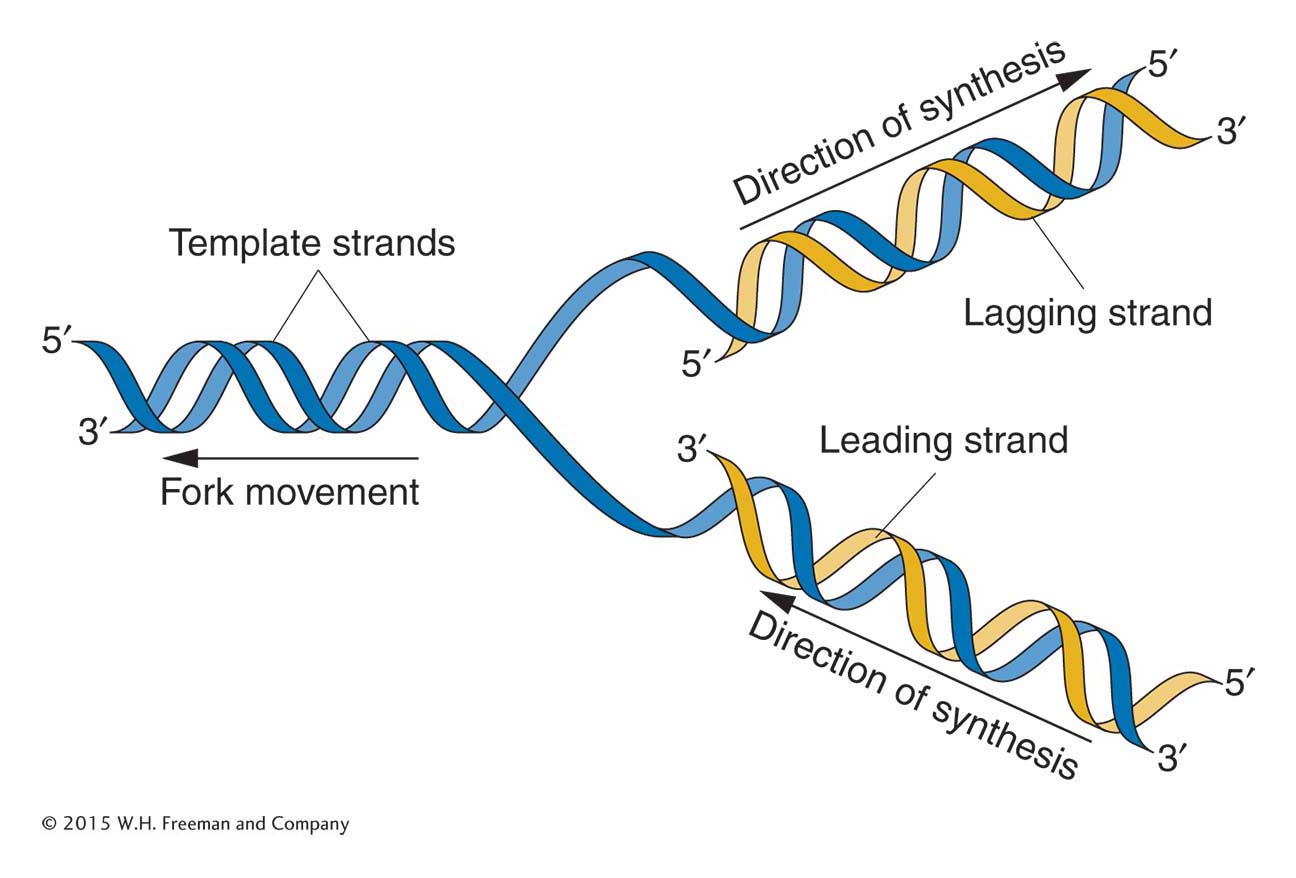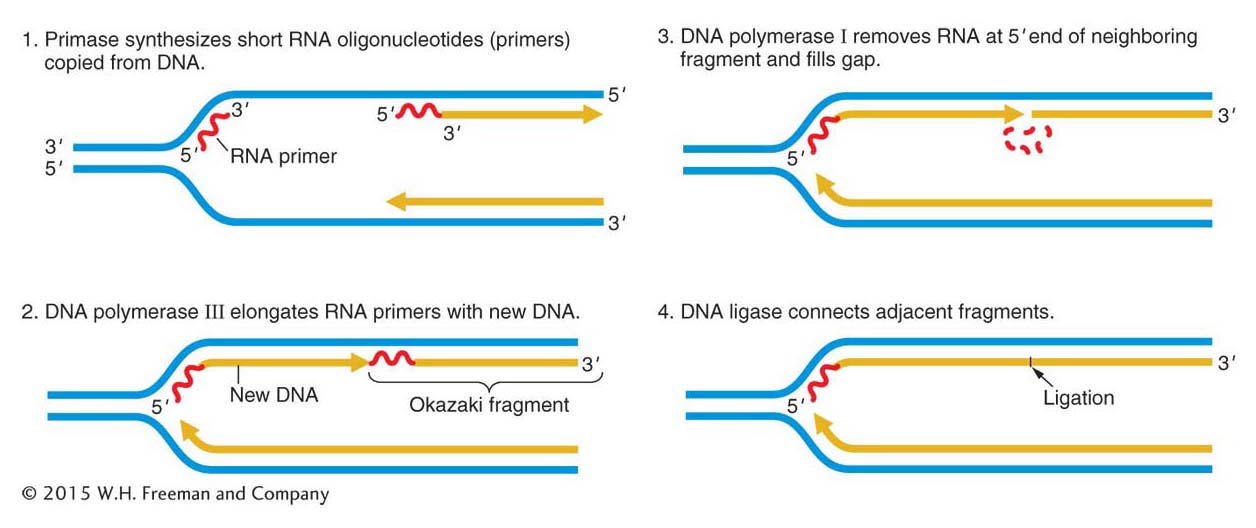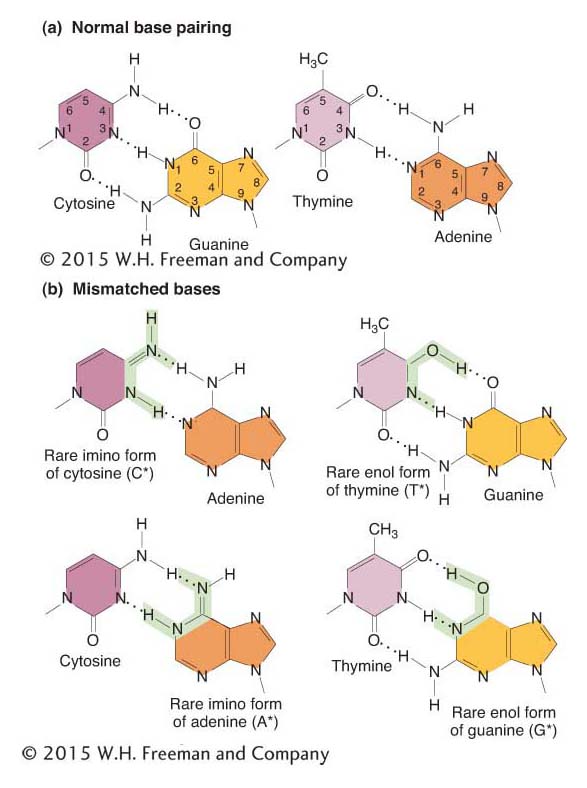7.4 Overview of DNA Replication
As DNA pol III moves forward, the double helix is continuously unwinding ahead of the enzyme to expose further lengths of single DNA strands that will act as templates (Figure 7-16). DNA pol III acts at the replication fork, the zone where the double helix is unwinding. However, because DNA polymerase always adds nucleotides at the 3′ growing tip, only one of the two antiparallel strands can serve as a template for replication in the direction of the replication fork. For this strand, synthesis can take place in a smooth continuous manner in the direction of the fork; the new strand synthesized on this template is called the leading strand.
Figure 7-16: DNA replication at the growing fork

Figure 7-16: The replication fork moves in DNA synthesis as the double helix continuously unwinds. Synthesis of the leading strand can proceed smoothly without interruption in the direction of movement of the replication fork, but synthesis of the lagging strand must proceed in the opposite direction, away from the replication fork.
Page 275
Synthesis on the other template also takes place at 3′ growing tips, but this synthesis is in the “wrong” direction, because, for this strand, the 5′-to-3′ direction of synthesis is away from the replication fork (see Figure 7-16). As we will see, the nature of the replication machinery requires that synthesis of both strands take place in the region of the replication fork. Therefore, synthesis moving away from the growing fork cannot go on for long. It must be in short segments: polymerase synthesizes a segment, then moves back to the segment’s 5′ end, where the growing fork has exposed new template, and begins the process again. These short (1000–2000 nucleotides) stretches of newly synthesized DNA are called Okazaki fragments.
Another problem in DNA replication arises because DNA polymerase can extend a chain but cannot start a chain. Therefore, synthesis of both the leading strand and each Okazaki fragment must be initiated by a primer, or short chain of nucleotides, that binds with the template strand to form a segment of duplex nucleic acid. The primer in DNA replication can be seen in Figure 7-17. The primers are synthesized by a set of proteins called a primosome, of which a central component is an enzyme called primase, a type of RNA polymerase. Primase synthesizes a short (~8–12 nucleotides) stretch of RNA complementary to a specific region of the chromosome. On the leading strand, only one initial primer is needed because, after the initial priming, the growing DNA strand serves as the primer for continuous addition. However, on the lagging strand, every Okazaki fragment needs its own primer. The RNA chain composing the primer is then extended as a DNA chain by DNA pol III.
Figure 7-17: Synthesizing the lagging strand

Figure 7-17: Steps in the synthesis of the lagging strand. DNA synthesis proceeds by continuous synthesis on the leading strand and discontinuous synthesis on the lagging strand.
A different DNA polymerase, pol I, removes the RNA primers with its 5′ to 3′ exonuclease activity and fills in the gaps with its 5′-to-3′ polymerase activity. As mentioned earlier, pol I is the enzyme originally purified by Kornberg. Another enzyme, DNA ligase, joins the 3′ end of the gap-filling DNA to the 5′ end of the downstream Okazaki fragment. The new strand thus formed is called the lagging strand. DNA ligase joins broken pieces of DNA by catalyzing the formation of a phosphodiester bond between the 5′-phosphate end of one fragment and the adjacent 3′-OH group of another fragment.
Page 276
A hallmark of DNA replication is its accuracy, also called fidelity: overall, less than one error per 1010 nucleotides is inserted. Part of the reason for the accuracy of DNA replication is that both DNA pol I and DNA pol III possess 3′-to-5′ exonuclease activity, which serves a “proofreading” function by excising erroneously inserted mismatched bases.
Figure 7-19: Proofreading removes mispaired bases

Figure 7-19: DNA polymerase backs up to remove the A-C mismatch using its 3′-to-5′ exonuclease activity.
Given the importance of proofreading, let’s take a closer look at how it works. A mismatched base pair occurs when the 5′-to-3′ polymerase activity inserts, for example, an A instead of a G next to a C. The addition of an incorrect base is often due to a process called tautomerization. Each of the bases in DNA can appear in one of several forms, called tautomers, which are isomers that differ in the positions of their atoms and in the bonds between the atoms. The forms are in equilibrium. The keto form of each base is normally present in DNA, but in rare instances a base may shift to the imino or enol form. The imino and enol forms may pair with the wrong base, forming a mispair (Figure 7-18). When a C shifts to its rare imino form, the polymerase adds an A rather than a G (Figure 7-19). Fortunately, such a mismatch is usually detected and removed by the 3′-to-5′ exonuclease activity. Once the mismatched base is removed, the polymerase has another chance to add the correct complementary G base.
Figure 7-18: Bases may take on rare tautomeric forms prone to mismatch

Figure 7-18: Normal base pairing compared with mismatched bases. (a) Pairing between the normal (keto) forms of the bases. (b) Rare tautomeric forms of bases result in mismatches.
Page 277
As you would expect, mutant strains lacking a functional 3′-to-5′ exonuclease have a higher rate of mutation. In addition, because primase lacks a proofreading function, the RNA primer is more likely than DNA to contain errors. The need to maintain the high fidelity of replication is one reason that the RNA primers at the ends of Okazaki fragments must be removed and replaced with DNA. Only after the RNA primer is gone does DNA pol I catalyze DNA synthesis to replace the primer. The subject of DNA repair will be covered in detail in Chapter 16.
KEY CONCEPT
DNA replication takes place at the replication fork, where the double helix is unwinding and the two strands are separating. DNA replication proceeds continuously in the direction of the unwinding replication fork on the leading strand. DNA is synthesized in short segments, in the direction away from the replication fork, on the lagging strand. DNA polymerase requires a primer, or short chain of nucleotides, to be already in place to begin synthesis.



